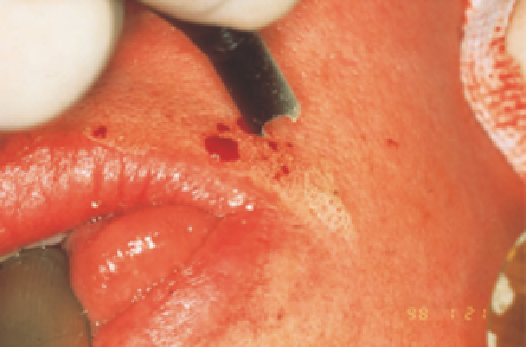Biomedical Engineering Reference
In-Depth Information
Figure 6.40
Tissue sculpting can be accomplished with the erbium laser, hold-
ing the beam at an acute angle to encounter higher tissue points selectively.
remaining erythema (20). Mean duration of erythema reported
after multipass short-pulsed Er:YAG laser has ranged from 1 to
4 weeks in most studies as compared with 1-3 months for most
patients after multipass treatment with CO
2
lasers (2,5,12).
Hyperpigmentation
Transient hyperpigmentation has been reported in up to 37%
of patients after CO
2
laser resurfacing, with a higher frequency
in patients with Fitzpatrick skin types IV and above. Transient
hyperpigmentation in patients with darker skin phototypes
also occurs frequently 4-6 weeks after treatment with the
short-pulsed Er:YAG laser.
In their large series of 625 patients treated with multiple
passes of a short-pulsed Er:YAG laser, Weinstein et al. observed
a transient hyperpigmentation rate of 3.4% (10). Ziering et al.
reported a 12% incidence of transient hyperpigmentation in
his series of 50 patients resurfaced with multipass short-pulsed
Er:YAG laser (7). Three additional studies that treated with
multiple passes of the short-pulsed Er:YAG reported transient
hyperpigmentation rates of 24% (13,20) and 25%, respectively
(5). Kye treated 30 patients with pitted facial scars and Fitzpat-
rick skin phototypes III and IV with multiple passes of a short-
pulsed Er:YAG and noted only two cases of hyperpigmentation
at the 3-month follow-up. All of his patients, however, were
treated preoperatively for 2-4 weeks with tretinoin 0.05% and
postoperatively for 2-4 weeks with a combination of hydro-
quinone 4%, tretinoin 0.05%, and hydrocortisone 1% (250).
In their series of 22 patients with Fitzpatrick skin phototype IV,
Sriprachya-Anunt et al. found no statistically signifi cant differ-
ence in the rate of transient hyperpigmentation induced by
treatment with either the CO
2
or the short-pulsed Er:YAG laser
alone, or a combination of both (273). Moreover, Kim et al.
resurfaced 190 patients with facial scars and Fitzpatrick skin
phototypes III and above with either the short-pulsed Er:YAG
laser or a modulated Er:YAG laser. They observed transient
hyperpigmentation rates of 24.7%, 42.3%, and 65.9% for the
short-pulsed, variable-pulsed (CO
3
, Cynosure, Chelmsford,
Massachusetts, USA), and the dual-mode (Contour, Sciton
Corporation, Palo Alto, California, USA) lasers, respectively
(274). Although hyperpigmentation in darker skin phototypes
appears to occur just as frequently with both the CO
2
and
Figure 6.41
Because the erbium laser does not leave enough residual thermal
necrosis to cauterize dermal vessels, bleeding will be encountered. Pinpoint
bleeding is fi rst seen in the upper papillary dermis and becomes more signifi -
cant as the upper reticular dermis is reached.
Er:YAG lasers, it is often less severe and of shorter duration
after Er:YAG laser resurfacing (275).
Hypopigmentation
Delayed-onset permanent hypopigmentation is thought to be
related to depth of ablation and the degree of residual thermal
damage. Reported in up to 16% of patients after CO
2
laser
resurfacing, hypopigmentation has a signifi cantly lower inci-
dence after short-pulsed Er:YAG laser resurfacing.
Alster resurfaced the face of 12 patients with Fitzpatrick
skin phototypes I-IV with multiple passes of six different
short-pulsed Er:YAG lasers and noted no instances of hypopig-
mentation (5) Weinstein observed a 4% incidence of delayed-
onset permanent hypopigmentation in a series of 625 patients
resurfaced with a short-pulsed Er:YAG laser (10). In their
series of 21 patients treated with multipass short-pulsed
Er:YAG laser, Khatri et al. noted a 5% incidence of hypopig-
mentation at the 6-month follow-up (20). Bass et al. reported
a 12% rate of hypopigmentation in their series of 25 patients
treated with multipass short-pulsed Er:YAG laser (13). In their
series of 190 patients with Fitzpatrick skin phototypes III and
above, Kim et al. found hypopigmentation rates of 8.0%,
15.3%, and 24.4% after resurfacing with the short-pulsed
Er:YAG, variable-pulsed Er:YAG (CO
3
, Cynosure), and dual-
mode (Contour®, Sciton Corp.) Er:YAG lasers, respectively.
The mean onset and duration of hypopigmentation in their
patient populations were 2 and 5.1 months, respectively. Only
15% of their patients had remaining hypopigmentation at the
12-month follow-up.

















